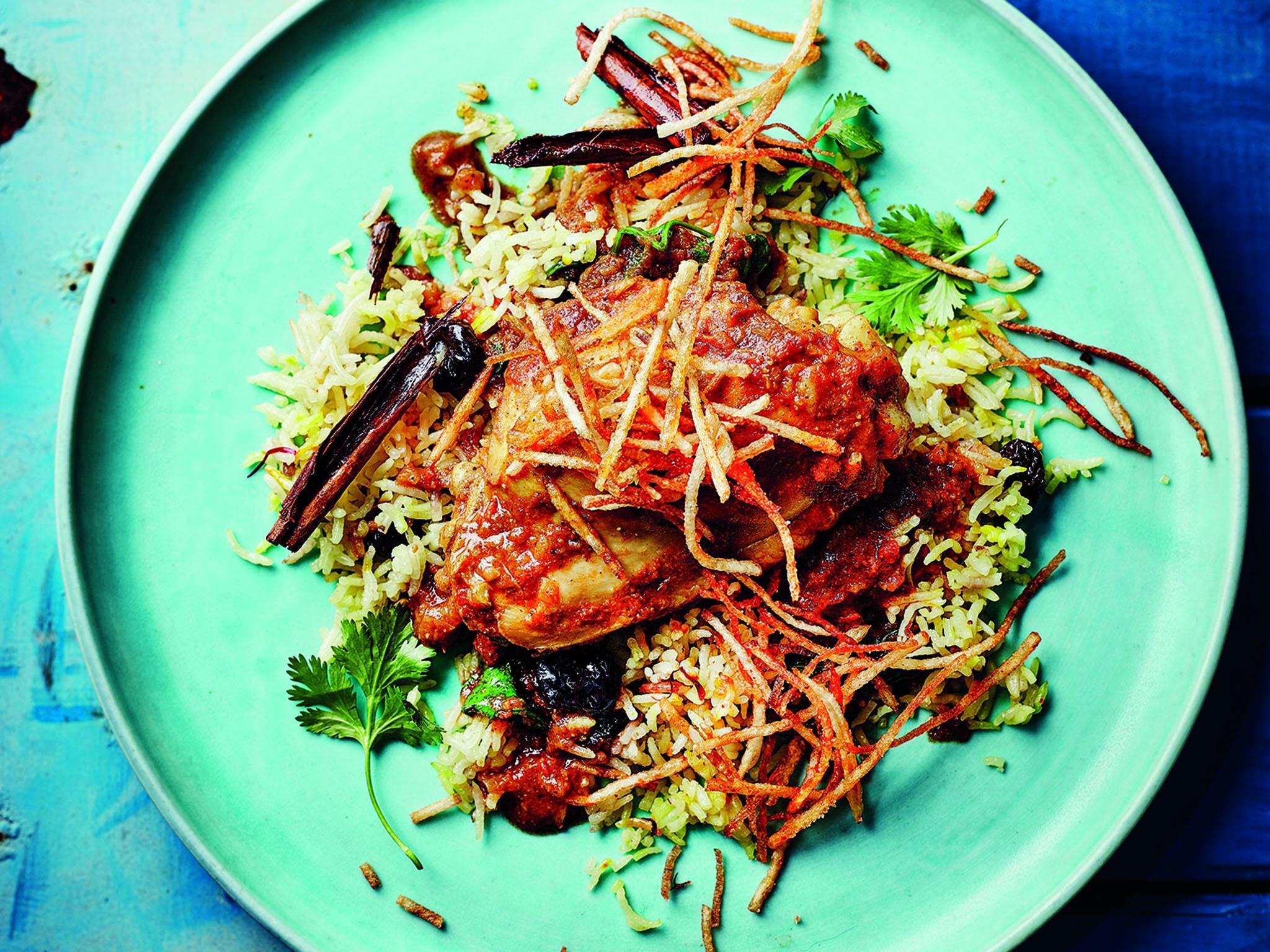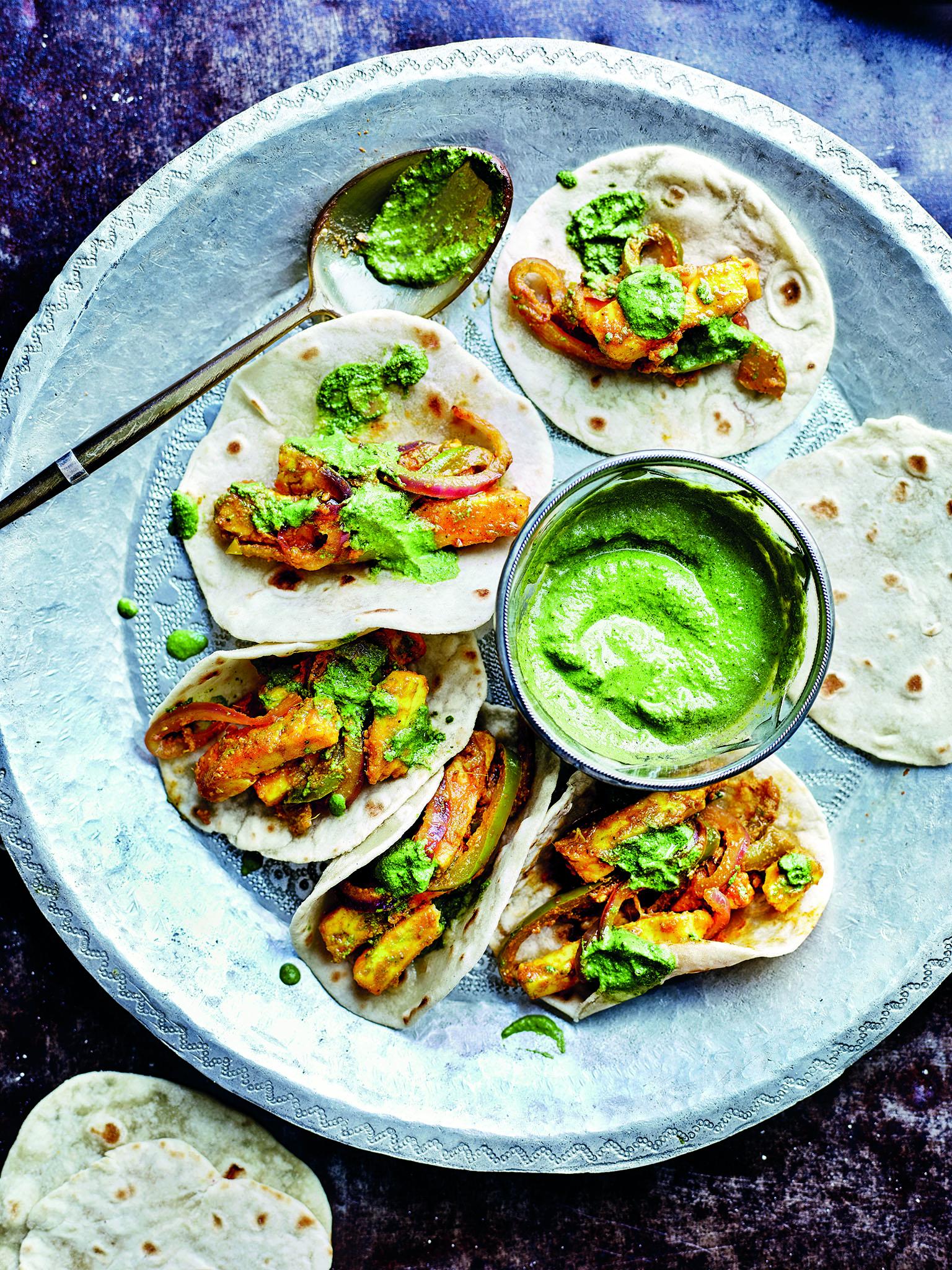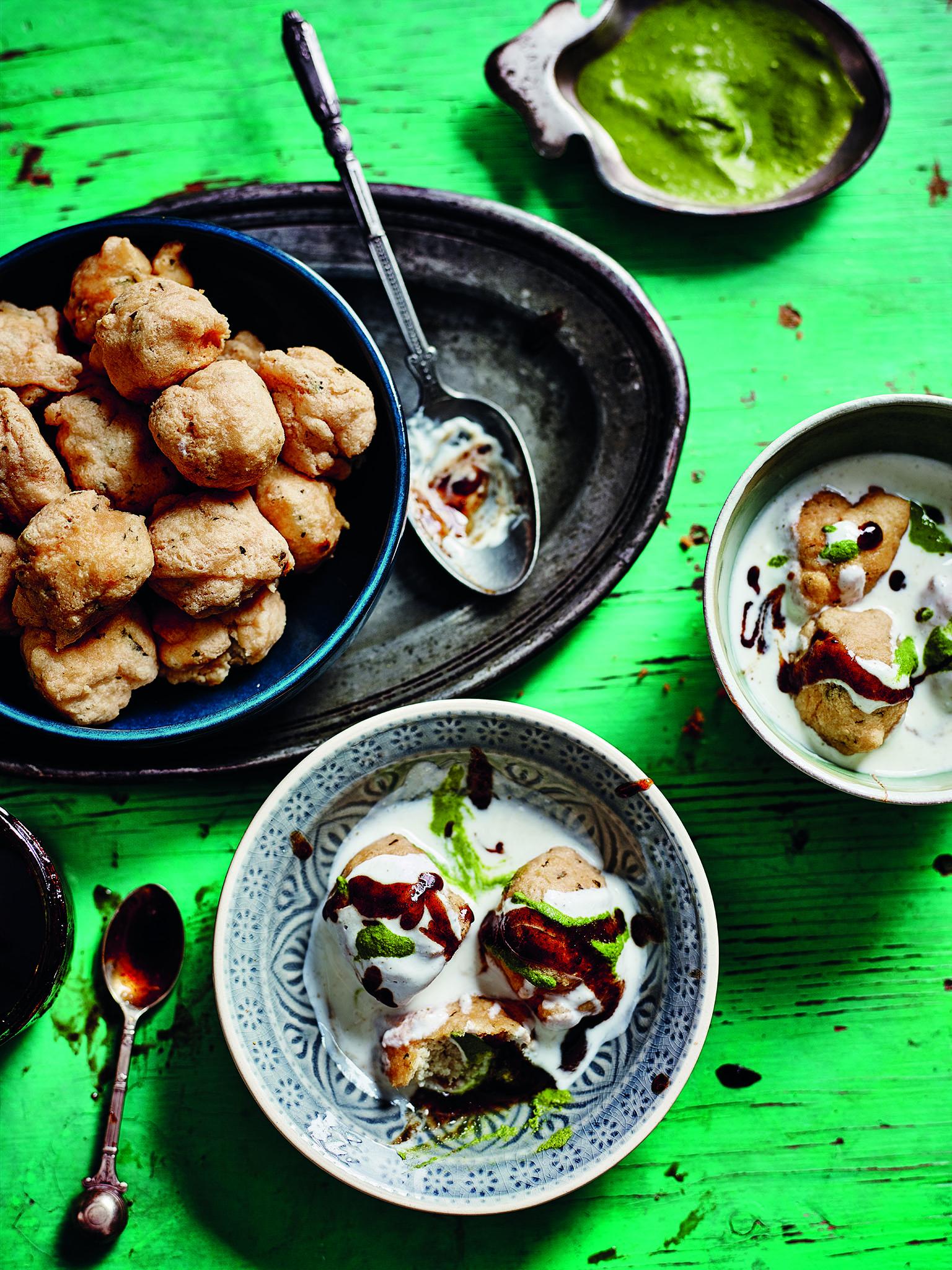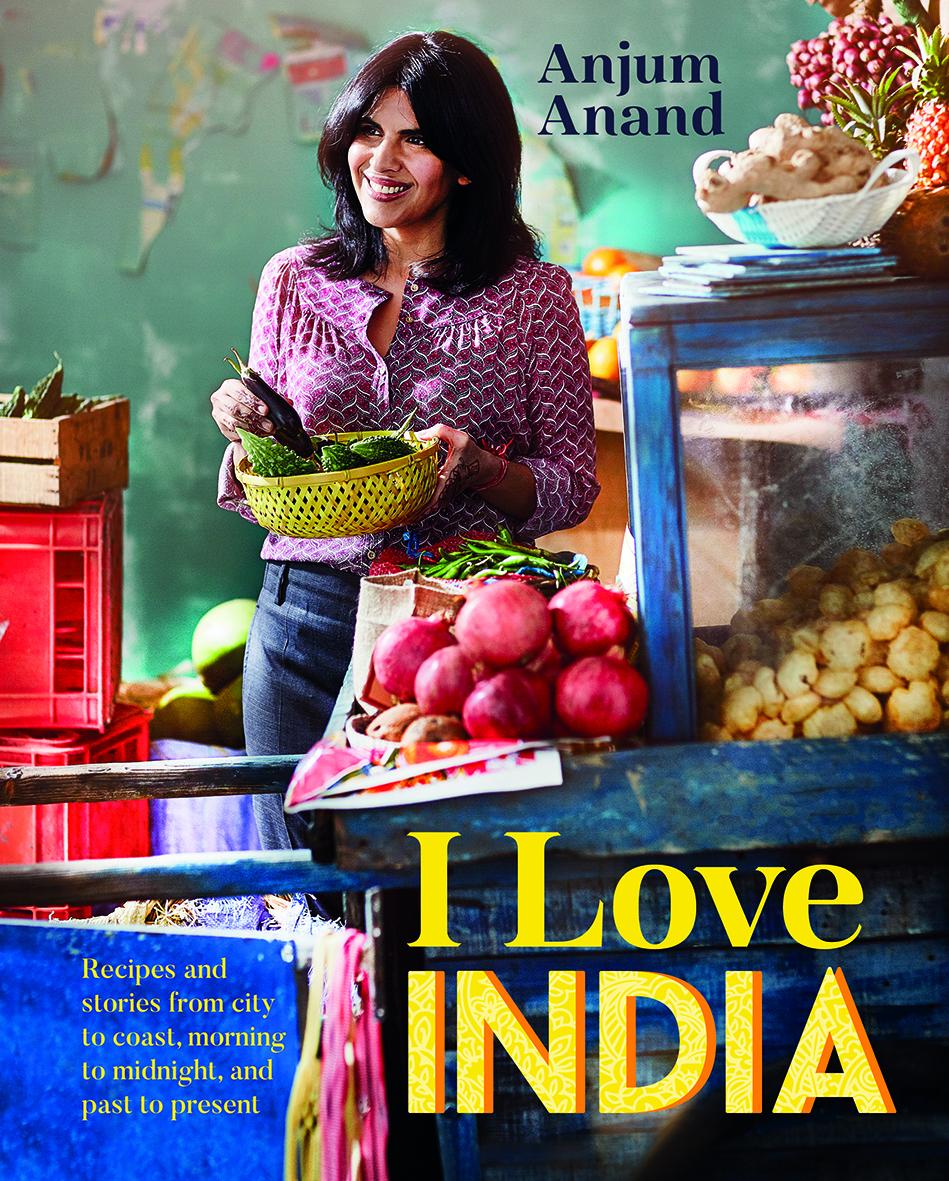I Love India: Recipes from home cooking to the city coast
The queen of Indian cooking, Anjum Anand, shares her personal selection of some of the country’s most authentic recipes from Persian cooking to the street food of Delhi

Parsi salli chicken
Parsis came to India from Persia hundreds of years ago, fleeing persecution, but a legend says that the Indian ruler didn’t want to let them in, saying, “We are full.” One Parsi asked the ruler to bring a bowl and fill it up to the brim with milk. He then added a spoon of sugar. The cup did not overflow. “We will be like the sugar,” he said. “We will only add sweetness to your country.” And indeed they did, and are now a very respected part of the community.
Parsi food is not only influenced by its Persian roots but also by the British and the Indians. This is one of their better-known dishes. I visited a well-known Parsi restaurant in Mumbai a few years ago. The owner has a giant portrait of the Queen. When he found out we were from England, he spent a good amount of time chatting with us. He recommended this chicken dish topped with salli: crispy fried potato straws.
Serves 4
4tbsps vegetable oil
2 onions, finely chopped
5g (1tsp) finely grated root ginger (peeled weight)
5 large garlic cloves, finely grated
3 large vine tomatoes (400g/14oz), blended until smooth
Salt and freshly ground black pepper
¾tsp ground cinnamon, or to taste
2tsp garam masala (fresh if possible)
½tsp ground turmeric
¼tsp chilli powder, or to taste
1 rounded tsp ground cumin
6-8 medium-small skinless bone-in chicken thighs (1.25-1.3kg/2lb 12oz-3lb in total)
Handful of coriander
Large handful of crispy potato salli (see below)
Heat the oil in a large non-stick saucepan over a medium heat. Add the onions and cook until soft. Then increase the heat and cook, stirring often, until golden brown. Add the ginger and garlic and cook gently for 1 minute, or until the garlic smells cooked.
Pour in the blended tomatoes, then add the seasoning and all the ground spices. Cook down until the masala releases oil, about 15-20 minutes. Taste – it should be harmonious. Tip the chicken into the masala along with a good splash of water. Bring to the boil, then cover, reduce the heat and cook for 25-30 minutes or until the chicken is cooked through. Give the pot occasional stirs as it cooks and check that there is enough water in the pan. At this stage you can make the crispy potato salli.
Taste and adjust the seasoning and consistency of the sauce, which should have a light, creamy consistency. If it is too watery, cook over a high heat until thickened to your liking, or add some water from a boiling kettle to loosen a little. Stir in the coriander, sprinkle with crispy potato salli and serve.
Crispy potato salli
Parsis love these delicate, crunchy potato straws. Needless to say they are really moreish and work very well with the flavours of the Parsi salli chicken. You can make these a day or two before.
Serves 4
2 large potatoes
Vegetable oil, as needed
Salt
Chilli powder (optional)
Peel the potatoes, slice thinly widthways, then line up some of the circles and slice into short matchsticks. (To slice my potato, I use the slicer on my box grater.) However you do it, try to slice them evenly. Place on a dish towel and pat dry.
Heat 7.5cm (3in) of oil in a wide, deep saucepan or in a deep-fat fryer to a medium heat (dip a shred of potato in: it should sizzle). Add the potatoes in batches, being careful not to overcrowd the pan. Cook over a medium heat until the potatoes are crispy and golden. You will need to carefully separate any clumps that stick together with a fork quite early on. Each batch will take 2-3 minutes. Remove using a slotted spoon and place on a plate lined with kitchen paper. Repeat to cook the rest.
Sprinkle over salt and chilli powder to taste and toss well to combine.

Mini paneer kathi rolls
Kathi rolls are hot Indian wraps and one of India’s favourite street foods. They come in many guises, few of which resemble cold wraps as we know them. I have probably tried most versions, buying them in bustling markets in New Delhi, exchanging money straight from the car window in Mumbai – where they are known as Frankies – and in hotels and homes as street food made its way off the street. Different places have their own versions and there are no strict rules: as long as a soft bread with a slight chew envelopes a fresh, hot, tangy filling with red onions for crunch, you are in the right zone and in for a treat. I make these often. They’re tasty, everyone loves them and they are easy to throw together. You can also substitute chicken for the paneer. If you are in a hurry, you can buy tortilla wraps and cut them in half, but homemade wraps are cheaper and tastier.
Makes 10 medium-small, or 15 tiny, rolls
100g plain yoghurt, not too sour
20g roughly chopped root ginger (peeled weight)
2 large garlic cloves
Scant ⅔ tsp garam masala (fresh if possible)
Scant ⅔ tsp ground cumin
1tsp chaat masala
½ tsp ground turmeric
2 tsp concentrated tomato purée
Salt
⅛ tsp chilli powder, or to taste
For the rolls
240g paneer, cut into small fingers 2cm wide x 5cm long
2 tbsps vegetable oil
¾ small green (bell) pepper, thinly sliced
Good handful of thinly sliced red onion rings
50ml tangy herb chutney (see below)
Freshly ground black pepper
For the wrap
125g (1 cup) plain (all-purpose) flour, plus more to dust
1tbsp vegetable oil
6-8tbsps water, or as needed
Blend together all the ingredients for the marinade. Season to taste with salt; I use 1tsp. Add the paneer, gently turn the pieces to coat, and leave to marinate as you prepare the dough.
Put the flour in a bowl and pour in the oil, water and a good pinch of salt. Knead together well; it will be a bit squelchy at the beginning but should become lovely and soft without cracks once it is done. Cover with a damp dish towel and leave to rest for 20 minutes.
To make the breads, place a tava or frying pan over a medium heat. Divide the dough into 10 pieces and roll each out on a work surface lightly dusted with flour into a thin, round bread around 13cm (5in) in diameter. Dust any excess flour off the bread and place on the pan.
Cook, turning once, until the bread has just a few light brown spots on both sides; it only takes a minute or so. Repeat to cook all the breads, stacking them on a dish towel, covering each with the corners as you go to help keep them soft. (You can also reheat them in some foil in the oven.)
Now back to the rolls. Heat the 2tbsps oil in a saucepan, add the pepper and stir-fry for 2 minutes. Add the paneer and all its marinade and cook, stirring often, until the liquid has reduced and you can see oil in the pan, 6-8 minutes or so. You might need to add a splash of water at some point once the pan gets dry. Add the onions and cook for another minute, or until the liquid now just coats the ingredients and is still moist. Take off the heat.
Working quickly, spoon a line of the filling down the centre of each wrap, top with 1 rounded tsp of tangy herb chutney, wrap them up and serve hot.

Delhi-style lentil dumplings in yoghurt
This is one of the dishes my mother would make on special occasions, but it is also a really popular cooling and nutritious streetfood. The tastiest version I have eaten is in Old Delhi in the large market of Chandi Chowk, which is known for its street food. I make a big batch of the dahi bhalla dumplings and freeze them, so I can put together this dish fairly easily in less than 10 minutes. This is quite a taste sensation in the mouth: sweet, savoury, soft and spongy and creamy all in one bite. Also, it is much lighter than it seems, as the batter doesn’t absorb much oil.
This is quite a traditional recipe but you can add other bits on top, like pomegranate seeds. Here, I cook up 25 so I can freeze half for another occasion, but make up only half the quantity if you prefer; people normally eat one or two each maximum.
For the dumplings (makes 25)
210g (1 cup) urad dal (split and skinned black lentils), soaked overnight
10g (2 tsp) finely grated root ginger (peeled weight)
½-1 Indian green chilli, stalk removed, or to taste
Vegetable oil
⅔ tsp baking powder
Small handful of chopped coriander
¾ tsp salt
To make up half of them (for 12 dahi bhalla)
450g plain yoghurt
90-110ml water
Salt
3tsp sugar, plus more if needed
¾ tsp roast and ground cumin seeds
Tangy herb chutney (see below), to serve
Drain off most of the water from the lentils, leaving 2-3tbsps, and place in a blender. Add the ginger and green chilli and grind until the batter is pretty smooth (though it might have some tiny granules in it). You can add water if necessary to help the blades turn, but the less water you add the better. The batter should feel light and fluffy.
Heat about 7.5cm (3in) oil in a medium-large karahi, wok or saucepan. It needs to be medium hot. Add the baking powder, coriander and salt to the batter and give it few extra whisks to incorporate as much air as possible. Place a bowl of water near the hob. Dunk your fingers in it and scoop up a large walnut-sized amount of batter. Using your thumb to help ease it off, let it slide into the hot oil. You need to be really close to the oil for it not to splash up, but do be careful. Don’t overcrowd the pan; you may need to fry the dumplings in 3 batches.
Fry for 6-7 minutes or until lightly golden. Remove with a slotted spoon, draining off excess fat and place on kitchen paper. Repeat to cook the rest. When you are ready to eat, place the dumplings in a large bowl of recently boiled hot water for about 3-4 minutes, so they absorb all the water. Meanwhile, whisk together the yoghurt, measured water, salt, sugar and roast cumin until smooth. The mixture should be the consistency of single (light) cream. Add some cold water to the dumpling bowl so you don’t burn your fingers, and gently squeeze out the water. A lot of oil comes out as well.
Place straight into a serving bowl or plate. Spoon over the yoghurt so the dumplings are covered, then spoon or drizzle over first the tamarind chutney and then the coriander chutney, so each dumpling has some of both. Serve or refrigerate to use later. It is served both at room temperature and chilled.
Tangy herb chutney
This is a lovely, versatile chutney that is tangy and herby rather than sweet. It is the cornerstone of all north Indian snacks. We love it with our samosas, bhajis, pakoras, kebabs and most other things. There are many variations: some will add a little sugar, some raw garlic, and others yoghurt. This is how we like it in my family and it is a perfect base from which to experiment if you want.
Makes 200ml

60g coriander leaves and some stalks
2tbsps lemon juice, or to taste
20g (¾ packed cup) mint leaves
25g pistachios (shelled weight)
Salt
½ garlic clove (optional)
4tbsps water
Blend all the ingredients until smooth and creamy; it might take a minute or so. Taste and adjust the seasoning and tang (lemon juice) to taste. Keep in an airtight glass jar in the fridge or freeze until ready to use.
‘I Love India’ by Anjum Anand is published by Quadrille on 9 March, £20. Photography: Martin Poole
Join our commenting forum
Join thought-provoking conversations, follow other Independent readers and see their replies
Comments